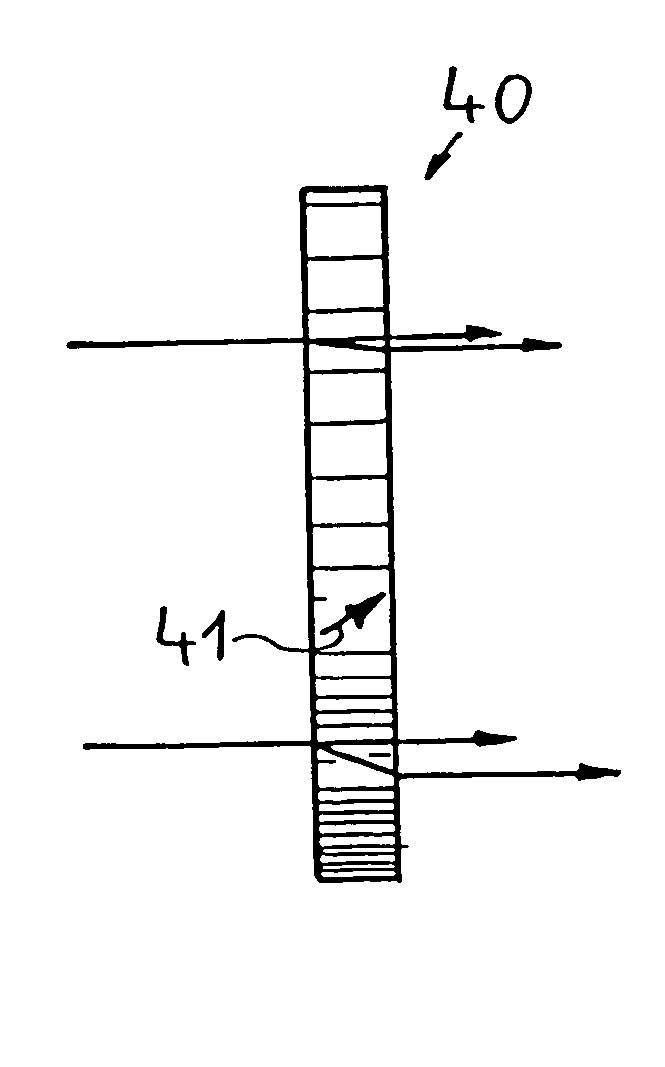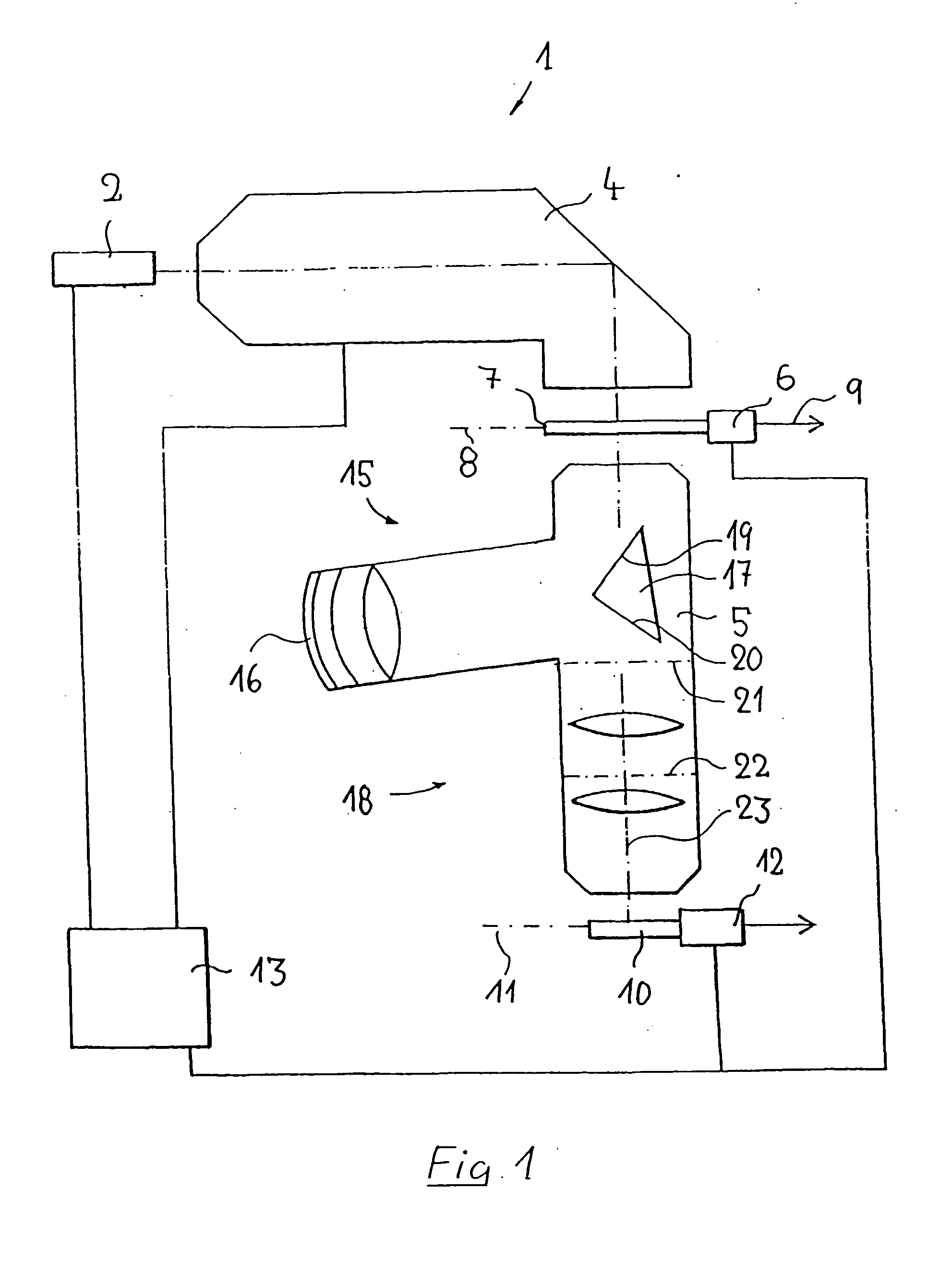[0013] One object of the invention is to provide an illumination method, particularly one that may be employed in microlithography, a projection lens that will be suitable for use in conjunction with same, and a method for fabricating the projection lens that will allow avoiding the disadvantages of the prior art. It is another object to provide a projection lens that allows imaging patterns such that their images will exhibit virtually no contrast variations due to differences in their orientations. SUMMARY OF THE INVENTION
[0021] A desired difference in the lengths of the optical paths traversed by the light rays having differing polarization directions that will depend upon the locations of the traversals and the traversal angles involved will thus be created by incorporating at least one means for optically correcting for the difference in the lengths of the optical paths that has been especially adapted to suit the projection lens, where the desired difference in the lengths of the optical paths will be such that it will exactly compensate for any undesired difference in the lengths of the optical paths caused by the other optical components of the projection lens. The difference in the lengths of the optical paths may be described in terms of a differential
wavefront that will be defined at every point on the illuminated field and may vary from point to point thereon. The compensated difference in said optical path lengths cannot be further compensated employing conventional means that affect light having differing polarization directions equally and are thus incapable of compensating for any difference in their respective optical path lengths. However, means for optically correcting for same that are in accordance with the invention can be employed for compensating for those imaging errors due to stress
birefringence and employment of
dielectric coatings mentioned at the outset hereof and will thus improve the performance of said projection lens. The means for optically correcting for the difference in
optical path length are alternatively denoted as
optical correction means throughout this application. The proposed correction of the relative-phase surfaces of mutually orthogonal polarization directions will not alter the field amplitudes and thus will not adversely affect the brightnesses of partial images. On the contrary, the locations and shapes of said partial images will be altered such that all of same will occur at the same locations and have the same shapes. The effect may be achieved by arranging that the compensation will be such that light rays having mutually orthogonal polarization directions will have traversed optical paths of virtually equal length upon arrival at the image plane of the projection lens. A corresponding effect will also occur if a difference in the lengths of the optical paths that will remain constant over the range of the angles of incidence involved is introduced.
[0022] The invention is based on the recognition that the polarization-sensitive effects, in particular, such due to employment of materials exhibiting stress birefringence or employing
dielectric coatings on optical components that involve large angles of incidence, will cause the wavefronts for s-polarized and p-polarized light to differ at the image plane, where the wavefronts for s-polarized and p-polarized light may be tilted with respect to one another, astigmatically distorted, defocused, and / or otherwise distorted due to various departures from design specifications and fabrication tolerances that may occur from projection lens to projection lens. Since light having differing polarization directions interfere independently, pairs of partial images that may be vertically or laterally displaced with respect to one another or displaced with respect to one another along the
optical axis of the projection lens, where the displacements along the
optical axis of the projection lens may also vary with the orientations of those patterns being imaged, will be created. The invention eliminates the displacements of partial images having a specific polarization in order to avoid variations in
image contrast due to variations in the orientations of the patterns.
[0023] Imaging errors may also vary over the optically utilized field. The dependence upon location will lead to variations in their
critical dimension (CD) over the field, which will cause the images of lines having equal widths to have widths that will vary with the latter's locations within the field, which, in turn, may further degrade the qualities of the finely patterned devices fabricated. However, the invention is also capable of eliminating these types of imaging errors.
[0025] In the case of reduction lenses of the type, the angles of incidence on the first, coated, deflecting mirror are larger than those on the second, coated, deflecting mirror. The inventor has determined that the predominant effect of the coatings employed on the deflecting mirrors is a tilting of the wavefronts of s-polarized and p-polarized light toward the scanning direction (y-direction). The partial images created by s-polarized and p-polarized light may be laterally separated by several nanometers due to the tilting alone, which will cause the partial images of lines oriented along the scanning direction to be effectively superimposed on one another, while the partial images of lines orthogonal to the scanning direction will be displaced, yielding pairs of parallel lines, which will smear out and broaden the images of the lines, which is why a preferred other embodiment of the highly preferable type of projection lens provides that the compensation for the difference in the optical path lengths of light rays having differing polarizations will introduce a gradient, preferably a
linear gradient, in the difference in the optical path lengths transverse to the
optical axis of the projection lens that will allow compensating for the tilting of the wavefronts. A suitable means for optically correcting for the tilting of the wavefronts might have at least one wedge-shaped retarding element fabricated from a birefringent material, i.e., from a material whose optical properties vary with polarization direction, where the retarding element may be fabricated from, e.g.,
magnesium fluoride or strained
calcium fluoride. Suitably orienting a retarding element of the type in the vicinity of a pupillary plane of the projection lens, i.e. in or near that pupillary plane, will accurately compensate for any tilting of the differential
wavefront due to the former's
wedge shape. Adding a second wedge fabricated from an isotropic material whose optical properties are independent of polarization will then effectively transform the combination of the wedge-shaped retarding element and the second wedge into a plane-
parallel plate that will have only a slight, evenly balanced, effect on light rays having either polarization direction.
[0037] Prospective compensating effects of the means of
optical correction according to the invention are not confined to the compensation for
wavefront tilting that has have been described above in terms of examples. For example, concentric differential-wavefront aberrations, such as those that may occur when polarized light transits antireflection coatings on lenses at large angles of incidence, are also correctable, either alternatively, or in addition thereto. Employing more complexly shaped and / or strained means of
optical correction and / or more complexly configured gradients in their birefringent effects will allow compensating for arbitrary distortions of the differential wavefront of s-polarized and p-polarized light.
 Login to View More
Login to View More  Login to View More
Login to View More 


